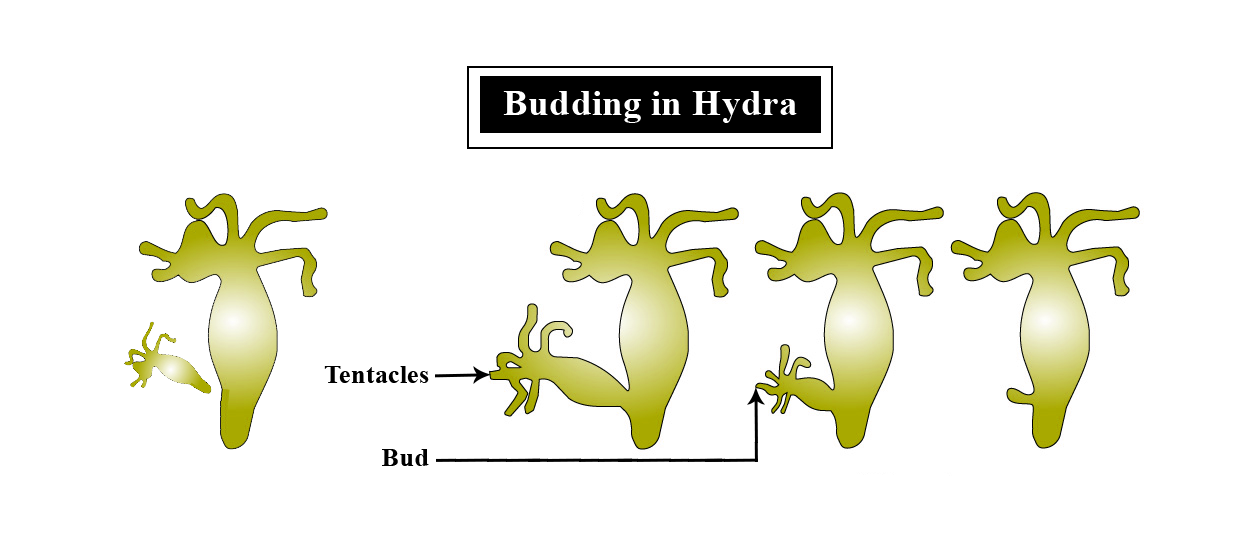
What is budding?
Answer
557.1k+ views
Hint: In certain lower organisms, reproduction is done by an outgrowth that is capable in the formation of another organism. Yeast, corals etc are the organisms that reproduce by this method.
Complete answer:
The process of reproduction in which an outgrowth is observed on the body of an organism and after some time it detaches from the body and develops into an organism. It is a type of asexual reproduction commonly found in Hydra.
Let us see how budding occurs:
In Hydra, the bud is the result of the repeated cell division that occurs at one specific site. The bud forms many small tiny individuals which stay attached with the parent for sometime and eventually detach and develop itself into new organisms. The new individual is formed by mitosis. It is a common method of asexual reproduction observed in some protozoa and lower organisms.Sponges (Scypha), Coelenterates (Hydra), Annelids (Syllis), Yeast, and Tunicates (Salpa) are some of few examples..
Budding is of two types:
Exogenous budding: As the name suggests, the bud grows from the outer surface of the parent body. It is commonly seen in Hydra.
Endogenous budding: When the bud emerges from the inner side of the body it is known as endogenous budding. As practiced by Sponges.
Note: Some parasites also follow endodyogeny in which the two daughter cells are formed inside the mother cell, and when the time of the separation comes nearer the mother cell is consumed by the offspring. It is observed in Toxoplasma gondii.

Complete answer:
The process of reproduction in which an outgrowth is observed on the body of an organism and after some time it detaches from the body and develops into an organism. It is a type of asexual reproduction commonly found in Hydra.
Let us see how budding occurs:
In Hydra, the bud is the result of the repeated cell division that occurs at one specific site. The bud forms many small tiny individuals which stay attached with the parent for sometime and eventually detach and develop itself into new organisms. The new individual is formed by mitosis. It is a common method of asexual reproduction observed in some protozoa and lower organisms.Sponges (Scypha), Coelenterates (Hydra), Annelids (Syllis), Yeast, and Tunicates (Salpa) are some of few examples..
Budding is of two types:
Exogenous budding: As the name suggests, the bud grows from the outer surface of the parent body. It is commonly seen in Hydra.
Endogenous budding: When the bud emerges from the inner side of the body it is known as endogenous budding. As practiced by Sponges.
Note: Some parasites also follow endodyogeny in which the two daughter cells are formed inside the mother cell, and when the time of the separation comes nearer the mother cell is consumed by the offspring. It is observed in Toxoplasma gondii.

Recently Updated Pages
Why are manures considered better than fertilizers class 11 biology CBSE

Find the coordinates of the midpoint of the line segment class 11 maths CBSE

Distinguish between static friction limiting friction class 11 physics CBSE

The Chairman of the constituent Assembly was A Jawaharlal class 11 social science CBSE

The first National Commission on Labour NCL submitted class 11 social science CBSE

Number of all subshell of n + l 7 is A 4 B 5 C 6 D class 11 chemistry CBSE

Trending doubts
1 Quintal is equal to a 110 kg b 10 kg c 100kg d 1000 class 11 physics CBSE

Why is steel more elastic than rubber class 11 physics CBSE

What is boron A Nonmetal B Metal C Metalloid D All class 11 chemistry CBSE

What is Environment class 11 chemistry CBSE

Bond order ofO2 O2+ O2 and O22 is in order A O2 langle class 11 chemistry CBSE

How many squares are there in a chess board A 1296 class 11 maths CBSE




